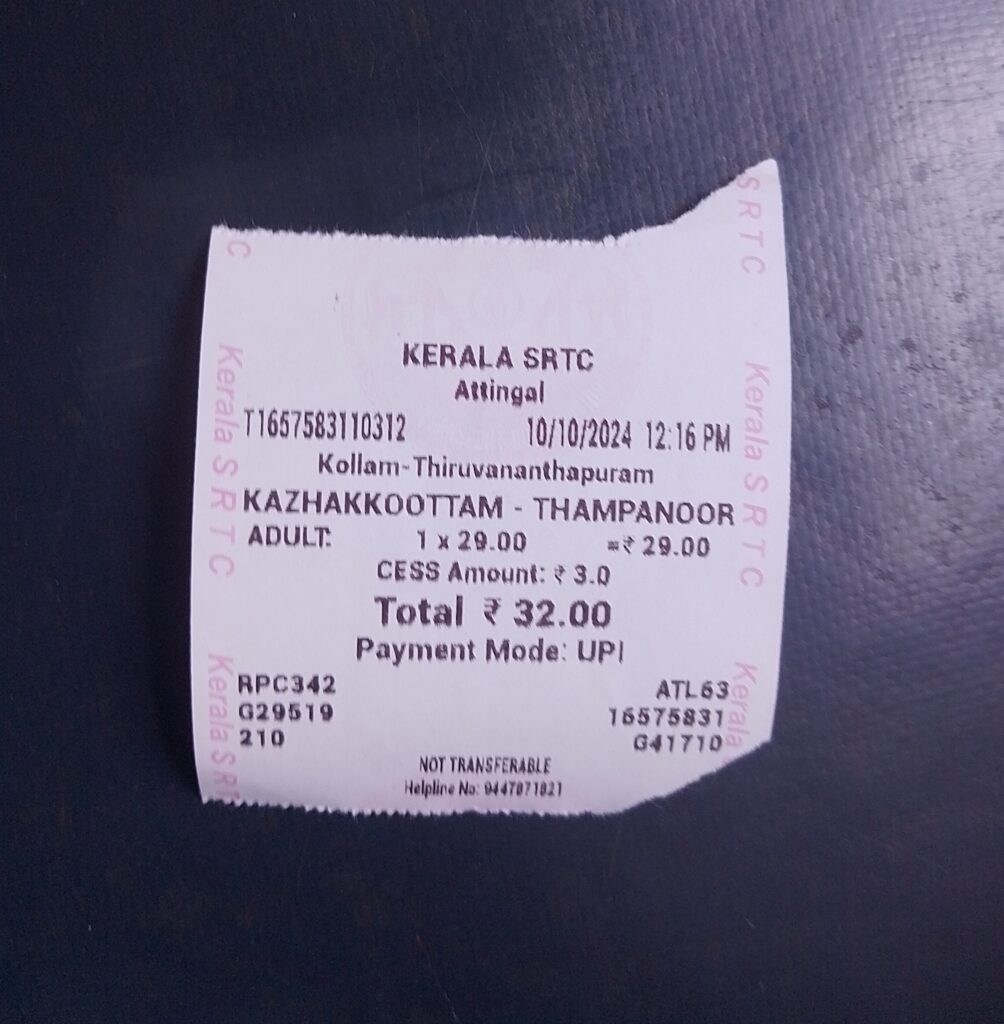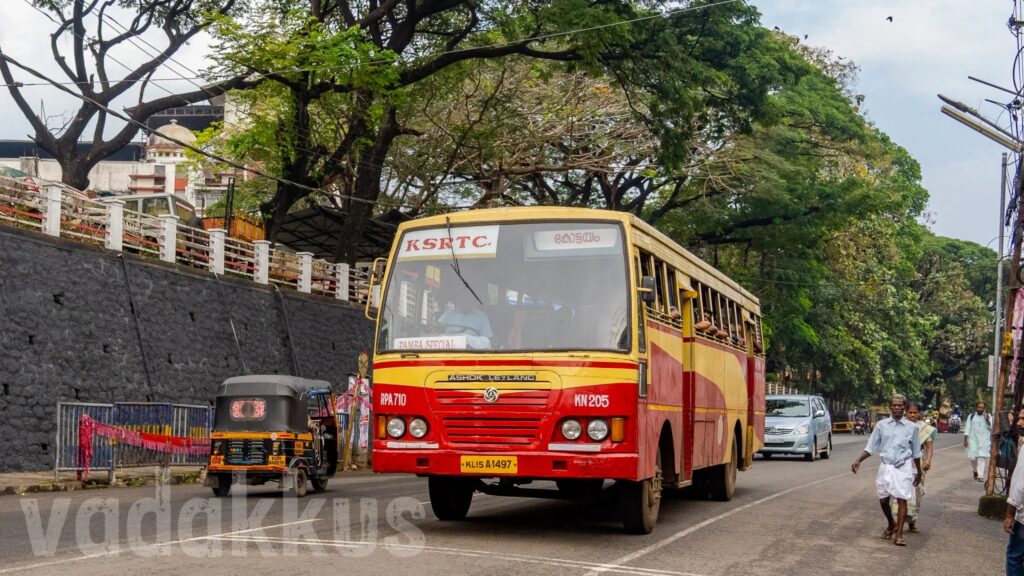I had written about how public transport has been left behind in India’s digital small payments revolution, and how we should be moving towards non-cash fare payment methods on Indian buses. As it turns out, the Kerala State Road Transport Corporation (KSRTC) had some time ago enabled UPI payment on some of its buses. Nearly no one knows about it since it was given no publicity at all. Even I didn’t!
So I was on my way from Kazhakoottam to Thampanoor (Trivandrum Central station) on KSRTC Attingal depot’s RPC 342 Tata Fast Passenger bus working a Kollam – Thiruvananthapuram FP service. I of course didn’t have the change for the Rs.32 fare with me. The conductor bus expressed his helplessness to break a Rs.100 note as the bus was fairly empty as it was off-peak hours. As I sat there wondering and starting to get angry about the state of public transportation and the frustrating inability and unwillingless of the powers that are to make things better, he made a startling suggestion: “Google Pay cheyyamallo?” (“You could do a Google Pay?“)
My immediate thought was, of course, I could (personally) Google Pay (UPI) him Rs.32 for the ticket.
Yes sure, I said, and pulled out my phone. I was about to ask him for the number when he held his ETM (electronic ticketing machine) in front of me. On the screen was a QR code.
That was when it clicked. These machines were enabled for UPI payment via QR codes! Kerala KSRTC is accepting UPI Payments! Oh wow this is revolutionary! nodded at him and opened the scanner on Google Pay and pointed it at the QR code expecting payment to happen in a millisecond. Except, it wasn’t that easy. (Unlike on Karnataka KSRTC buses where we have to scan a QR code pasted in the bus and then enter the fare amount manually, in Kerala KSRTC buses the ETM generates the QR code with payment info embedded on the screen which when scanned shows the amount to be paid on the app directly without having to enter it.)
The phone wouldn’t focus lock on the QR code! I quickly realised that this was because the phone camera was trying to focus on the screen cover of the ticketing machine’s pouch!
KSRTC’s electronic ticketing machines, supplied by CHALO are same size and type of the modern credit card POS machines (the PineLabs type). Conductors carry them in a sling pouch with the large touchscreen visible through a sheet of plastic. This plastic cover is full of creases and has a highly reflective texture. The phone camera focuses on the first thing it sees, which is this light-reflecting uneven plastic. It does not “see” the QR code on the screen underneath the cover. And the bumpy ride of the bus made it twice as difficult.
The conductor then handed me the ticketing machine. I tried zooming in, out, changing angles, but no luck. I didn’t want to try smoothening out the plastic lest should I touch the screen of the machine and screw something up. Finally when I was about to suggest that I take the machine out of the pouch, the phone locked on and scanned the QR. GPay immediately processed the code and showed a payment of Rs.32 to KSRTC. I quickly paid this using a bank account which the machine instantly processed. I handed the machine back, the conductor printed out the ticket and went on his way.
In all, my first UPI payment process on a KSRTC bus took more than a minute. Not really very radical.

My experience confirmed most of my apprehensions regarding UPI payment on buses in Kerala. The main reason being it is very hard to get a focus on the QR code on a moving bus.
- The bus was driving through heavy traffic with constant stop-and-go braking and accelerating making the ride very bumpy and uneven making it difficult to hold the phone and focus on the code.
- There were not many passengers in the bus. The conductor had plenty of time to spare as only two including me had boarded from the previous stop. It would’ve been a different story if the bus was crowded.
- I hadn’t even thought of the whole “plastic view cover obstructing the QR code” thing.
As it turns out, paying with cash is still easier and smoother than using UPI on running commuter buses.
Yes, UPI would work well on long-distance buses that only stop once a while and take on only seating-capacity passengers. On buses that frequently stop every couple of kilometers to take on tens of passengers and can have around a hundred people on board at any given time, paying for tickets using UPI would be a difficult proposition. I can safely say that my first UPI payment wouldn’t have been possible if the bus was crowded or the conductor was short-tempered. At one point I even thought of giving up and telling him to get me the change after the bus had reached the terminus.
UPI is not the best method to make transit payments
We tend to think of QR code payments to be the smoothest and easiest ever. This is because usually the environment is always static and motionless during the process. Trying to scan a QR code on a moving bus makes for a radically different experience. Both the code and the phone trying to scan it are in constant motion in all directions. You have to get your phone, open the app, get a focus lock on the QR, enter your PIN all with one hand while trying to get a handhold with your other, again all the while trying to get your balance on the moving bus. And that is when you find that your phone camera stubbornly doesn’t want unfocus from the plastic cover. What if we had something that just plain deducts payment from your account without having to have a finicky device involved in between? Like I said earlier, the best method for making payments on buses exists, and it is not cash or UPI.
When it comes to paying for transit fare on buses and all other methods of public transportation, the NFC-enabled pre-loaded transit (travel) card remains option that provides the easiest, fastest, most frictionless and seamless experience. It is like cash without the change hassle.
Of course, UPI along with credit or debit cards should be available as an option for making payments on buses, but the push should be to mainstream transit cards as the default mode of payment on buses. For the current situation, CHALO could try doing something about the ticketing machines so it becomes easier to scan the QR codes.
My experience with QR codes on buses perfectly showcases how even the latest shiny new tech can fail spectacularly in specific real world conditions.
Technology in specific real-world applications
It is common to see the “latest shiny techy thing” as the uniformly applicable solution to all of the world’s ills. For instance many people applaud introduction of UPI payments on KSRTC buses because they see it exactly as that latest shining techy thing that would seemingly solve all problems and boost the image of the talking points of our public transportation. They rarely think about the applicability or practicability of those applications because they do not think about it like how it is in this case.
As we can see here, even a robust system like UPI can falter as it reacts differently when applied in different environments. In this case it took only one specific and insignificant real-world element or detail (that probably no one even thought about) to render all the technology and project useless. This is probably a good case study for technology development for real-life applications. Also, do they do any UAT testing at all before deployment?
Also, it is moot that few among the “latest shiny techy thing” crowd actually take the bus. Most daily commuters are those who are not very well versed with the usage of UPI or smartphones or bank accounts.
Instead of trying to beat drums for impractical solutions that look good for optics that will seemingly work inside our head but will ultimately fail when adopted in real life, we should be focusing on things that are easy to use, make practical sense in the real world and will be widely adopted. It is infuriating that there are so many methods to make acceptability of public transport mainstream and widespread, but there’s so little effort or interest spent towards it. Hopefully things will improve as technology pushes its way through and people become better aware.
UPI payments are being rolled out in phases. It is currently available on buses with a CHALO ticketing machine only. All SWIFT buses will probably have the facility as of now.
In the following weeks I made around six more UPI payments on KSRTC buses and the experience was exactly the same every time. The phone tries to scan the machine screen cover instead of the QR code. Twice I had to revert to paying by cash as the bus was crowded. And the machines do not accept cards yet.
Also Read:

India needs to figure out Travel/Transit cards
India needs to promote travel/transit cards rechargeable using UPI as the default method of payment on public buses and trains to ensure everyone on public transportation is not left out of the digital small payments revolution.




